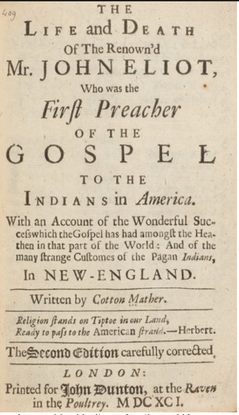|
More than 300 years ago in northern New England, a seven-year-old girl was kidnapped by Native Americans who held her captive in the wilds of Maine, then forced her to march to Quebec, Canada in the dead of winter. Sold to the French, the young girl was eventually returned to her home in Dover, New Hampshire. The tale of Sarah Gerrish, my 7th-great aunt, was told throughout Boston where the Puritan leader, Reverend Cotton Mather, used it as a stark warning about the dangers of Native Americans and Catholics. Gerrish’s experience featured a classic Puritan captivity narrative, in which “a single individual, usually a woman, stands passively under the strokes of evil, awaiting rescue by the grace of God. The sufferer represents the whole chastened body of Puritan society.” (Richard Slotkin, Regeneration through Violence, 1973.) Sarah’s Story One rainy June night in 1689, Sarah Gerrish was sleeping in the fortified garrison of her grandfather, Richard Waldron, the most powerful man in the frontier outpost of Dover, New Hampshire. She was innocent of her grandfather’s misdeeds, which included double-crossing the Pennacook tribe 13 years earlier. The Pennacooks took their revenge in the nighttime raid when they tortured Waldron then killed him, most likely in front of his granddaughter. (Waldron’s story is told in full here.) The raiders killed 23 settlers and took 29 captives, including Sarah, who was rushed out of the garrison with time to put a stocking on only one foot. Walking barefoot through the woods of Maine was the least of the hardships Sarah would face over the next several months. According to the report sent to Cotton Mather in Boston by Reverend Pike in Dover, Sarah was first held captive by a sachem named Sebundowit, who later sold her to another sachem who Mather described as “a more harsh and mad sort of dragon.” For six months, Sarah was held in Maine and Mather reported two incidents of psychological terror. “Once her master commanded her to loosen some of her upper garments and stand against a tree while he charged his gun. The poor child shrieked out: ‘He is going to kill!’ But instead he warned her and let her be.” On another occasion, her captives built a large fire and told her she was to be roasted. She burst into tears, threw her arms around her master's neck and begged him to save her, which he promised to do if she would behave well. She survived a near-drowning when pushed into a river fully clothed by some Native American girls and at some point she realized that she would likely die if left alone in the deep woods. One morning she overslept and the Native Americans had picked up camp and left her behind. With snow on the ground and no food, she tracked her captives and rejoined their ranks. When the Native Americans holding her reached Quebec, Sarah was sold to the wife of the French Intendant, who put her in the nunnery. The nuns were said to have adored the young girl and to be saddened when she returned home. After less than a year in Quebec, a British attack against the French city fort failed and in the ensuing exchange of prisoners, Sarah Gerrish was turned over and sailed to Boston. She was reunited with her family, the Gerrishes, in Dover. She died eight years later at the age of 16 and her story lived on as an example of how a devout Puritan can overcome evil in life.
3 Comments
|
Names of My AncestorsPuritans & Servants Archives
February 2019
Categories |





 RSS Feed
RSS Feed
